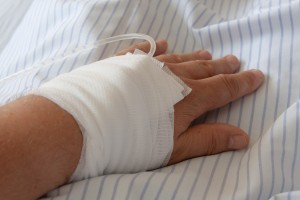- Calls to this hotline are currently being directed to Within Health, Fay or Eating Disorder Solutions
- Representatives are standing by 24/7 to help answer your questions
- All calls are confidential and HIPAA compliant
- There is no obligation or cost to call
- Eating Disorder Hope does not receive any commissions or fees dependent upon which provider you select
- Additional treatment providers are located on our directory or samhsa.gov
Failed Outpatient Treatment with Bulimia: Next options for Treatment
Contributor: W. Travis Stewart, LPC, NCC writer for Eating Disorder Hope
 Bulimia Nervosa is a life-threatening condition and can result in significant medical, mental and personal problems. Seeking treatment at the appropriate level of care is critical to restoring health and wellness.
Bulimia Nervosa is a life-threatening condition and can result in significant medical, mental and personal problems. Seeking treatment at the appropriate level of care is critical to restoring health and wellness.
In order to find the right level of care it is important for individuals, families and professionals to understand what treatment options are available and what they include.
Outpatient
 The “entry level” of care is outpatient. This is what most people think of when they hear about counseling. You go to see a professional at his or her office, typically once per week. For someone with bulimia he/she will also likely see a registered dietitian and a medical provider. If the individual continues to struggle, she could possibly increase the number of times that she sees the counselor each week.
The “entry level” of care is outpatient. This is what most people think of when they hear about counseling. You go to see a professional at his or her office, typically once per week. For someone with bulimia he/she will also likely see a registered dietitian and a medical provider. If the individual continues to struggle, she could possibly increase the number of times that she sees the counselor each week.
According the National Eating Disorder Association (NEDA) the criteria for outpatient care is:
- Patient is medically stable and no longer needs daily medical monitoring
- Patient is psychiatrically stable and has symptoms under sufficient control to be able to function in normal social, educational, or vocational situations and continue to make progress in recovery
Intensive Outpatient Program (IOP)
While in this level of care the patient/client continues to live at home and come into a treatment setting several hours a day for counseling and nutritional help. Often this will include eating at least one meal per day in the treatment facility. The number of days per week can vary from 3-6 depending upon the intensity of the symptoms and medical condition. The criteria recommended by NEDA is the same as outpatient. Typically this level of care is recommended when the patient is not making progress at the outpatient level of care given time to work at that level.
Partial Hospitalization Program (PHP)
 At this level things are becoming more intense. PHP generally involves treatment from morning to evening. Programs differ in what is included at this level of care but, it is common for the patient to eat all of her meals in treatment. Sometimes a patient may come in after breakfast at home or she may be responsible to eat a snack in the evening after returning home. Monitoring of the patient is included at this level of care which helps to stop the cycle of bingeing and purging. NEDA lists the following criteria for PHP care:
At this level things are becoming more intense. PHP generally involves treatment from morning to evening. Programs differ in what is included at this level of care but, it is common for the patient to eat all of her meals in treatment. Sometimes a patient may come in after breakfast at home or she may be responsible to eat a snack in the evening after returning home. Monitoring of the patient is included at this level of care which helps to stop the cycle of bingeing and purging. NEDA lists the following criteria for PHP care:
Patient is medically stable but:
- Eating disorder impairs functioning, though without immediate risk
- Needs daily assessment of physiologic and mental status
Patient is psychiatrically stable but:
- Unable to function in normal social, educational, or vocational situations
- Engages in daily binge eating, purging, fasting or very limited food intake, or other pathogenic weight control techniques
Residential Treatment
 Residential treatment means that patients will now spend 24 hours a day in a treatment setting. This length of stay at the residential level of care can vary widely, depending upon a variety of factors including medical stability, the amount of weight needed to be gained by the patient and the determination of the insurance company. Treatment centers will do their best to help keep patients at the appropriate level of care and generally like to provide as much support as possible during the stay. At this level all meals are included as well as medical care, nutritional counseling, individual, group and family counseling. The criteria from NEDA state:
Residential treatment means that patients will now spend 24 hours a day in a treatment setting. This length of stay at the residential level of care can vary widely, depending upon a variety of factors including medical stability, the amount of weight needed to be gained by the patient and the determination of the insurance company. Treatment centers will do their best to help keep patients at the appropriate level of care and generally like to provide as much support as possible during the stay. At this level all meals are included as well as medical care, nutritional counseling, individual, group and family counseling. The criteria from NEDA state:
- Patient is medically stable and requires no intensive medical intervention.
- Patient is psychiatrically impaired and unable to respond to partial hospital or outpatient treatment.
Inpatient Treatment
 Inpatient treatment means that a patient is essentially hospitalized. What this looks like practically can vary widely depending on the facilities available to the treatment center. In some cases it looks very much like a hospital setting. In other cases the facilities are very comfortable and not really separate from the residential treatment. Only the level of supervision and medical care are increased.
Inpatient treatment means that a patient is essentially hospitalized. What this looks like practically can vary widely depending on the facilities available to the treatment center. In some cases it looks very much like a hospital setting. In other cases the facilities are very comfortable and not really separate from the residential treatment. Only the level of supervision and medical care are increased.
The focus at this point is to medically stabilize the patient. This means more aggressive medical interventions, significant limitations on patient independence and more intensive monitoring – possibly even 1:1 individual attention from a nurse or mental health technician. At this point NEDA identifies the following criteria:
Patient is medically unstable as determined by:
- Unstable or depressed vital signs
- Laboratory findings presenting acute health risk
- Complications due to coexisting medical problems such as diabetes
Patient is psychiatrically unstable as determined by:
- Rapidly worsening symptoms
- Suicidal and unable to contract for safety
Considering the Intensity and Frequency of Behaviors
 One of the primary considerations in determining the level of care for bulimia nervosa is how frequently an individual is using bingeing and purging behaviors. According to the Diagnostic and Statistical Manual of Mental Disorders, 5th Edition (DSM-5), an individual is diagnosed with bulimia when considering a number of factors, including experiencing a lack of control when eating and self-evaluation that is unduly influenced by body shape and weight. Additionally, binge-purge behaviors are happening at least once a week for at least three months.
One of the primary considerations in determining the level of care for bulimia nervosa is how frequently an individual is using bingeing and purging behaviors. According to the Diagnostic and Statistical Manual of Mental Disorders, 5th Edition (DSM-5), an individual is diagnosed with bulimia when considering a number of factors, including experiencing a lack of control when eating and self-evaluation that is unduly influenced by body shape and weight. Additionally, binge-purge behaviors are happening at least once a week for at least three months.
If a patient is participating in a level of care (such as outpatient) and is not seeing an improvement in the thinking and acting out of these behaviors, then a higher level of care should be considered. Additionally, if there is a lack of motivation, denial or worsening medical conditions, an increase in treatment should be considered.
Finally, any accompanying anxiety, depression, suicidality or self-harm behaviors should be considered and factored into determining a level of care. The more that are present, the more likely a higher level of care should be considered.
Other Options
In addition to stepping up the level of care for the client/patient other options should be considered. These include:
- Participating in group therapy – This, in addition to individual counseling, can be very beneficial, especially for individuals who are motivated but feeling discouraged about their progress.
- Online support groups – Organizations such as FINDINGbalance (findingbalance.com) and Mentor Connect (mentorconnect-ed.org) offer online support groups for those who want increased encouragement, accountability and support from peers.
- Recovery Coaching – these professionals offer additional support to individuals struggling with eating disorders and provide coaching in the use of skills to deal with urges, increase motivation and will work alongside therapists to help the client take the next step in recovery.
Community Discussion – Share your thoughts here!
Have you or your loved one had a failed attempt at outpatient treatment? What next steps were taken? What advice do you have to share?
About the Author
Travis Stewart earned a Master of Arts in Counseling (2001) and a Master of Arts in Theological Studies (2003), both from Covenant Seminary in St. Louis, MO. Travis is a Licensed Professional Counselor in the State of Missouri and a writer for Eating Disorder Hope and Addiction Hope.
The opinions and views of our guest contributors are shared to provide a broad perspective of eating disorders. These are not necessarily the views of Eating Disorder Hope, but an effort to offer a discussion of various issues by different concerned individuals. We at Eating Disorder Hope understand that eating disorders result from a combination of environmental and genetic factors. If you or a loved one are suffering from an eating disorder, please know that there is hope for you, and seek immediate professional help.
Last Updated & Reviewed By: Jacquelyn Ekern, MS, LPC on October 5, 2015. Published on EatingDisorderHope.com

